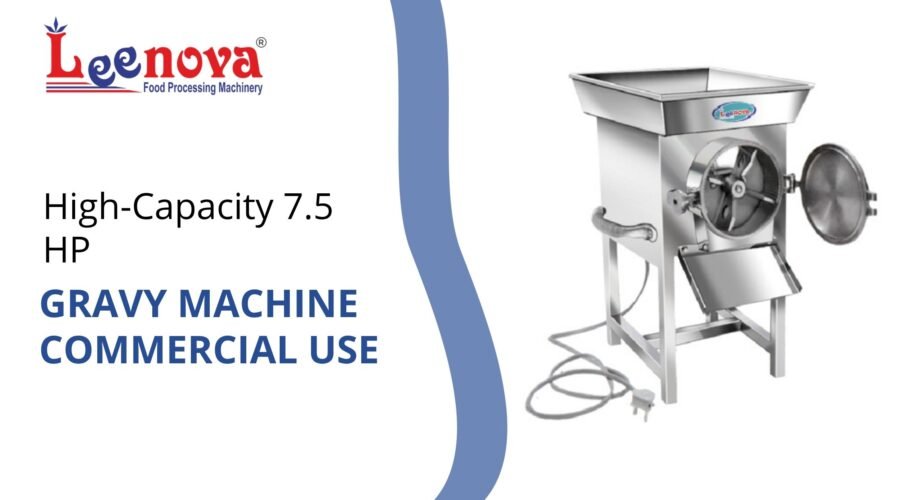Running a commercial kitchen means facing the same problem every day: manually grinding vegetables, spices, and gravy bases eats up hours. Staff stand over traditional grinding stones or use multiple smaller machines that can’t keep up with peak hour demand. A high-capacity 7.5 HP gravy machine transforms this bottleneck into a streamlined operation, processing 600-700 kg of ingredients per hour with consistent quality. This machine doesn’t just speed things up—it cuts labor costs by up to 40% and reduces the physical strain on kitchen staff, addressing the labor shortage that’s hitting 52% of food service operators. This piece walks through what makes these machines essential, how they work, and why commercial operations can’t afford to ignore them.
What Makes a 7.5 HP Gravy Machine Different
The motor power sets this machine apart. A 7.5 HP three-phase motor delivers enough torque to pulverize hard vegetables like raw onions, ginger, and beetroot without overheating or stalling. Most kitchens start with 2-3 HP models and quickly realize they need more capacity during service hours.
Here’s what changes with 7.5 HP capacity:
- Processing speed jumps to 600-700 kg per hour versus 20-60 kg for smaller units
- Chamber size expands to 14×7 inches, handling larger batches without constant refilling
- Three-phase power ensures continuous operation during peak demand
- Stainless steel construction withstands acidic ingredients like tomatoes and tamarind
Built for Volume, Not Just Speed
Commercial kitchens don’t just need fast machines—they need consistent output over 8-12 hour shifts. The 7.5 HP configuration runs continuously without motor burnout, something that surprises operators who’ve burned through smaller units in six months.
Core Applications That Drive ROI
Restaurant automation studies show that 84% of operators with kitchen automation equipment report strong return on investment, but only if the equipment matches actual workflow needs. A 7.5 HP gravy machine fits specific scenarios better than others.
High-Volume Restaurant Kitchens
Multi-cuisine restaurants processing 30-50 kg of gravy base daily see payback within 4-6 months. The machine handles wet grinding for north Indian gravies, south Indian chutneys, and base sauces without flavor cross-contamination between batches.
Catering Operations and Cloud Kitchens
Catering services preparing 200+ meal orders need consistent paste texture across batches. Manual grinding creates variation—one batch comes out chunky, the next too watery. Automation ensures every order tastes identical, which builds repeat business.
Food Processing Units
Small-scale spice grinding units and pickle manufacturers use these machines for batch processing. The semi-automatic operation lets one worker manage multiple grinding cycles, dropping labor requirements from three staff members to one.
How Commercial Operators Use This Machine
The machine operates in wet and dry modes, but most commercial use focuses on wet grinding. Here’s the actual process that kitchens follow:
Preparation takes 10 minutes: roughly chop vegetables, add water in a 3:1 vegetable-to-water ratio, and load the chamber to 80% capacity. The machine pulverizes ingredients in 2-3 minutes for smooth paste or 60-90 seconds for coarse grinding. One operator can process six batches per hour, replacing the work of three people using traditional methods.
The Surprising Productivity Pattern
Most kitchens expect to use this machine during lunch and dinner prep. The unexpected use case: overnight batch processing for next-day service. One operator runs multiple cycles between midnight and 6 AM, prepping gravy bases that stay fresh refrigerated for 24-48 hours. This shifts labor from peak to off-peak hours and eliminates morning rush bottlenecks.
Maintenance That Actually Matters
Neglecting maintenance cuts machine life by 60%. These three tasks prevent most breakdowns:
Daily cleaning means rinsing the chamber and blades immediately after use, before paste dries. Dried tomato or onion paste hardens overnight and damages blade edges. Weekly inspection covers motor mounts, belt tension, and blade sharpness. Monthly lubrication of motor bearings and moving parts prevents friction wear.
The chamber and blades disassemble without tools, cutting daily cleaning from 20 minutes to under 5 minutes. Operators who skip this step face blade replacement costs of ₹3,000-5,000 every three months versus yearly replacement with proper care.
Key Selection Criteria for Commercial Buyers
Choosing equipment based on motor power alone leads to mismatches. Chamber size matters more than most buyers realize—a 14×7 inch chamber processes nearly double the volume of a 12×6 inch chamber per cycle.
Material and Build Quality
Food-grade stainless steel resists corrosion from acidic ingredients and withstands daily sanitization. Machines built with mild steel bodies save ₹8,000-12,000 upfront but fail health inspections and rust within 18 months of heavy use.
Phase configuration determines installation requirements. Three-phase power delivers stable torque but requires industrial electrical connections. Single-phase alternatives exist for 5 HP and below, but they can’t sustain continuous operation at 7.5 HP capacity.
Real Cost Analysis
The upfront investment runs ₹45,000-65,000 depending on build quality and features. Monthly operating costs include electricity (₹800-1,200 for 8-hour daily use) and maintenance parts (₹500-800 average).
Labor savings tell the real story. Replacing two grinding staff members at ₹15,000 monthly each saves ₹30,000 in labor costs. The machine pays for itself in 2-3 months of operation, then generates net savings of ₹25,000-28,000 monthly after accounting for electricity and maintenance.
The Counter-Intuitive Part About Automation
Kitchen automation reduces labor costs, but the bigger win comes from speed and table turnover. Restaurants using automated prep equipment serve 15-20% more customers during peak hours because kitchen output doesn’t bottleneck. That revenue increase often exceeds labor savings.
Common Problems and Quick Fixes
Motor overheating during continuous use signals overloading. Drop batch size by 15-20% and add more water to the grinding mix. Inconsistent paste texture means dull blades—replace or sharpen every 4-6 months under heavy use.
Excessive vibration indicates loose motor mounts or unbalanced blade assembly. Tighten mounting bolts and check for bent blades. Loud grinding noise points to bearing wear, which requires immediate service to prevent motor damage.
FAQs
Can this machine handle dry spices and wet ingredients?
Yes, but not simultaneously. Wet grinding works best for vegetables, chutneys, and gravy bases. Dry spice grinding requires removing excess moisture and running shorter cycles to prevent paste formation. Most commercial operators use dedicated dry grinders for spices to avoid flavor transfer.
What’s the actual lifespan under daily commercial use?
Expect 5-7 years with proper maintenance and daily cleaning. Heavy-duty operations running 10+ hours daily see 4-5 year lifespans. Motor replacements extend life by another 2-3 years at roughly 40% of new machine cost.
Does chamber size really matter for small operations?
More than motor power for operations under 100 kg daily volume. Smaller chambers mean more frequent loading and unloading, which cuts actual productivity by 30-40%. A larger chamber reduces operator interaction time even if motor power exceeds immediate needs.
How does power consumption compare to manual grinding?
Electricity costs ₹800-1,200 monthly versus zero for manual methods, but labor costs for manual grinding run ₹25,000-30,000 for equivalent output. The total cost per kg processed drops by 60-70% with machine grinding.
Can one machine serve multiple cuisine types?
Yes, with thorough cleaning between different paste types. Indian, continental, and Asian cuisines use different base ingredients but similar paste consistencies. Clean the chamber completely between batches to prevent flavor cross-contamination.
Moving Forward
A 7.5 HP gravy machine eliminates the manual grinding bottleneck that limits kitchen output during peak hours. Commercial operations processing more than 50 kg of vegetables daily recover their investment within three months through labor savings and increased service capacity. The machine delivers consistent paste quality, reduces physical strain on staff, and enables overnight batch processing that shifts labor to off-peak hours.
Purchase decisions should weigh chamber size, build material, and phase requirements against actual daily volume. Operations under 100 kg daily volume often perform better with 5 HP models and larger chambers versus overpowered smaller units.
Why Choose Leenova Kitchen Equipments
Leenova Kitchen Equipments has manufactured commercial food processing machinery since 2006, serving restaurants, catering operations, and food processing units across India. The company holds CE certification and ISO 9001:2015 certification, ensuring equipment meets international quality and safety standards.
Every machine undergoes factory testing before shipment, and technical support covers installation guidance, operator training, and maintenance troubleshooting. The Rajkot-based facility manufactures a full range of kitchen equipment, allowing integrated solutions for commercial operations.
Ready to eliminate your kitchen’s grinding bottleneck? Contact Leenova Kitchen Equipments for detailed specifications, pricing, and installation requirements for the 7.5 HP gravy machine. Visit the product catalog at leenovakitchenequipments.com or call for technical consultation on matching equipment capacity to operational needs.


